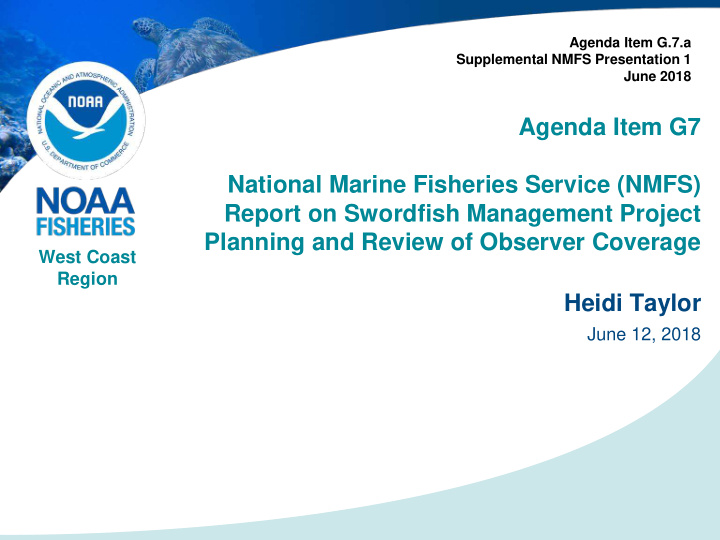



Agenda Item G.7.a Supplemental NMFS Presentation 1 June 2018 Agenda Item G7 National Marine Fisheries Service (NMFS) Report on Swordfish Management Project Planning and Review of Observer Coverage West Coast Region Heidi Taylor June 12, 2018
Background • In 2015, the Council published its draft Swordfish Management and Monitoring Plan (SMMP) to guide management of a holistic West Coast swordfish fishery • Section 3 of the 2015 draft SMMP outlines three goals: • (1) reduce protected species bycatch in the swordfish fishery through mitigation, gear innovation, and individual accountability • (2) reduce unmarketable finfish catch through the same mechanisms • (3) support the economic viability of the swordfish fishery U.S. Department of Commerce | National Oceanic and Atmospheric Administration | NOAA Fisheries | Page 2
U.S. West Coast Swordfish Fishery Overview U.S. Department of Commerce | National Oceanic and Atmospheric Administration | NOAA Fisheries | Page 3
U.S. West Coast Swordfish Fishery Overview U.S. Department of Commerce | National Oceanic and Atmospheric Administration | NOAA Fisheries | Page 4
ACTION 1: Reduce bycatch in the DGN fishery through hard caps and performance standards • Performance standards have been established for finfish and non-ESA-listed mammals, which are routinely reviewed by the Council • NMFS routinely monitors DGN interactions with all non-target species • NMFS recently made a negative determination on the Council’s proposed hard caps regulation • Due in part to significant adverse economic impacts to the small entities without alternatives identified to reduce costs that could be implemented • NMFS suggested the Council could minimize economic impacts by specifying a reduced time or area that the fishery would be closed if a cap was reached • NMFS developed statistical methods to better estimate rare-event bycatch (regression tree method) and is seeking funds to test the feasibility of electronic monitoring (EM) for the DGN fleet, especially for unobservable vessels U.S. Department of Commerce | National Oceanic and Atmospheric Administration | NOAA Fisheries | Page 5
ACTION 2: Limit fishing effort in the DGN fishery • Between 1996 and 2017, the number of DGN permits (active or inactive) issued by the state of California declined from 167 to 69 • NMFS issued a final rule establishing a Federal LE DGN permit in March 2018, based on Council recommendation • Originally intended to transition permit program from state to federal • All state permit-holders qualified for the federal permit. • The Council discussed further limitations on participation in the DGN fleet after the federal permit was established • NMFS provided example approaches (e.g., limiting permits based on bycatch reduction goals or transitioning DGN to other gear types). • The state of California continues to require DGN fishermen to obtain a state permit • Given these circumstances, the Council may wish to revise its stated Measure to compensate state permit holders U.S. Department of Commerce | National Oceanic and Atmospheric Administration | NOAA Fisheries | Page 6
ACTION 3: Allow access to the Pacific Leatherback Conservation Area (PLCA) • The PLCA was implemented in 2001 to mitigate takes of endangered Pacific leatherback sea turtles by the DGN fleet • A recent study (Eguchi et al., 2017) showed the PLCA is still the shortest and most effective closure to balance sea turtle avoidance and fishing • In February 2015, the Alliance for Sustainable Fisheries (ACSF) submitted an EFP application to fish with modified DGN gear in time/area zones, including in the PLCA • The Council recommended approval of the EFP application, but suggested adjustments to the proposed fishing activities • NMFS is interested in testing dynamic ocean modeling tools (e.g., Eco-Cast) as proposed in this EFP • However, NMFS remains concerned about approving access to allow testing with DGN gear in the PLCA at this time U.S. Department of Commerce | National Oceanic and Atmospheric Administration | NOAA Fisheries | Page 7
ACTION 4: Develop longline fisheries • In 2004, NMFS provided the Council with mitigation measures to consider when it disapproved the longline portion (i.e., fishing outside of the EEZ) of the HMS FMP • Studies show longline gear modifications (e.g., circle hooks, & finfish bait, etc.) have been effective in reducing bycatch (Swimmer et al. 2017; Foster et al. 2012) • SFD is in the final stages of its ESA- consultation on the EFP application proposing to test longline fishing in the EEZ under a suite of recommended mitigation measures • NMFS continues to support Council consideration of managing a longline fishery under the HMS FMP, as longlining produces the majority of swordfish landings to the U.S. West Coast U.S. Department of Commerce | National Oceanic and Atmospheric Administration | NOAA Fisheries | Page 8
ACTION 5: Develop deep-set buoy gear (DSBG) • In 2015, NMFS issued 5 EFPs to the Pfleger Institute of Environmental Science (PIER) to assess the potential of DSBG fishing • Preliminary results showed this gear to be effective for catching swordfish with minimal bycatch • NMFS received applications for DSBG EFP’s from 51 fishermen, which were reviewed by the Council • NMFS started issuing EFPs to vessels to fish with standard DSBG, following completion of a protected species workshop • NMFS plans to issue EFPs to for up to 12 vessels to fish linked DSBG for the 2018/2019 fishing season • The Council has been considering the authorization of DSBG as a legal gear type under the HMS FMP, and plans to gather input from its advisory bodies on criteria for a potential LE permit system during its September 2018 meeting U.S. Department of Commerce | National Oceanic and Atmospheric Administration | NOAA Fisheries | Page 9
Questions? U.S. Department of Commerce | National Oceanic and Atmospheric Administration | NOAA Fisheries | Page 10
Recommend
More recommend